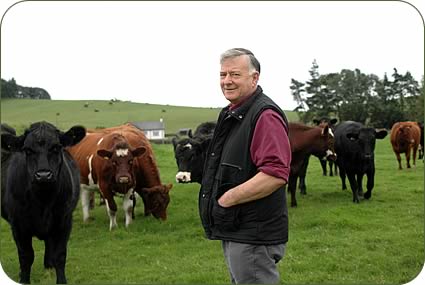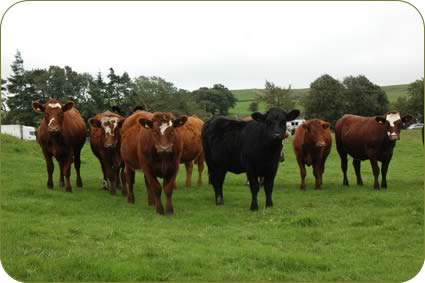Jennifer MacKenzie is an agricultural photo journalist with almost 30 year's experience. Operating from her base in Cumbria, Jennifer undertakes mainly industry-related freelance writing and photography.
Beef Shorthorn's come top of the list
When Glenkiln Farms’ manager George Somerville was faced with re-stocking
a herd of 500 suckler cows he set about listing all the traits he saw as
a priority for the 1,500 ha, mostly-hill estate, run only by a staff of
five.
He closely looked at all breeds of cattle for temperament, fertility, longevity,
milk, growth and length and depth of body to suit the estate’s hill
farms – and the Beef Shorthorn and Beef Shorthorn cross came top
of the list.
 |
| George Somerville |
From 1975 to 2001, Glenkiln Farms near Crocketford, Dumfries, owned by
Henry Keswick, ran a herd of 100 pure Galloway cows, which were noted for
their success in the show ring and exported world-wide - as well as commercial
cows.
As well as being renowned for its cattle, the estate is world famous for
the statues on its hills and glens by Henry Moore and other eminent sculptors,
Henry Moore being a good friend of Sir William Keswick, Henry Keswick’s
father.
The estate runs to 1,000ft above sea level and has a rainfall of 60 inches
a year in its own microclimate which makes the season three weeks behind
nearby Dumfries.
“I was open-minded. There are good cattle in all breeds. After I
awarded all the points the Shorthorn came out top of all the red-coloured
breeds,” said George.
“Temperament was very important. We wanted to breed our own herd
replacements and start our own pedigree herd. The next step was finding
the right cattle,” he added.
The plan was to buy a nucleus of pedigree Beef Shorthorns and buy commercial
cow herds to be crossed with the Beef Shorthorn bull to make up the rest
of the numbers.
Although, if he had been able to find herds to make numbers up to 500 Beef
Shorthorns at the time, George would have bought them.
“I went to see Major John Gibb at Glenisla, Blairgowrie and I was
very impressed with the type of cow he had and took into account the type
of land it was running on,” said George.
 |
| 17 to 18 month old in calf Beef Shorthorn sired heifers |
Glenkiln’s original cows were lost in the March of 2001 during the
foot and mouth epidemic and, keen to re-stock, George bought from Major
Gibb his home-bred bull Glenisla Noble and the Glenisla stock bull Dunsyre
Mercenary.
Also purchased was Fingask Phoenix from Willie McGowan in Fife. The bulls
were selected for their good legs, length and depth of body as well as
being well-fleshed.
Since then, stock bulls Killochries Nutmeg 2 and Moledan Sir Charles have
been used.
Females were bought from Major Gibb, John and Gill Redpath, also in Perthshire
and Kay Drysdale, from Coldingham, near Berwick to establish the nucleus
of a small herd principally to breed bulls for use at Glenkiln.
Some individual females have been added since with the view to running
20 to 25 pedigree cows in the Glenkiln herd.
The herd’s current stock bull the May 2003-born Glenkiln Hillside
is a home-bred son of Wenmar Nomad out of Aylward Rothes Queen 13. He was
used on the commercial cows first and produced impressive, thick calves
and he is now running with the pedigree cows.
“When pedigree breeders sell cattle they always keep their best but
no matter what breed, you should only be keeping the top 10 per cent as
only this will take the herd forward,” said George.
“I also believe that 75 per cent of the herd’s characteristics
are from the mother – temperament etc – I always try to see
a bull’s mother before buying it,” he added.
 |
| May 2003 born home-bred stock bull
Glenkiln Cambus at work with cross-bred cows. |
For the commercial cows, George looked further north in Scotland and bought
complete herds comprising cattle of all ages, mainly Simmental and Angus
crosses. Seven herds with stock bulls were bought and the estate re-stocked
by November 5, 2001.
Buying complete herds minimised disease risk and, with varying ages of
females, the original herds would be culled gradually.
“I wanted a cow with a bit of depth to convert grass well. I didn’t
want an animal with muscle which would need to be fed,” he said.
Since 2001, a lot of home-bred heifers have been added to the herd to achieve
a young-cow herd, culling those which were not doing a job. No replacements
have been bought in.
As the herd improved three Simmental bulls have also been bought in the
last year along with a South Devon to produce calves with a biggish frame
as the need for replacements is not so great.
“Half our commercial cows now have a Shorthorn sire. The Angus type
cows are producing a black calf while the Simmental crosses are producing
red calves, both of which the beef finisher is looking for. We will probably
continue crossing with the different bulls, although we have three quarter
and pure bred Shorthorns among the commercial cows.
“We’re very happy with our choice. The Shorthorns have to do
a job here. We haven’t got any fancy ideas we’re just trying
to make them work and fit into the system – and they are doing that
job!
“It says a lot if one man can bring in up to 50 cows with calves.
The Beef Shorthorns are like the Galloways – they have this hardiness
and can even be outwintered.”
“We have had a number of people buying bulls from us – however,
Shorthorn bulls are not short-lived. We produce our bulls naturally and
they wear. Two dairymen bought bulls and they have had no calving problems
with their Holstein cows.
“As far as replacement go, you get a lot of suckler cows which only
make their third or fourth calf but a cow like the Shorthorn, which can
easily produce 10 or 12 calves, keeps replacement costs down. Also these
cows are worth money as cull cows because of their weight.”
George cannot fault the Shorthorn for its fertility. He says a Shorthorn
bull can easily cover 40 to 50 cows and the aim is to get the herd at Glenkiln
calving in a tight 10 week period.
The majority of the cows are spring calvers, calving from March to May,
with the remainder from August to October. The aim is to have all the pedigrees
calving in the spring.
The cows are all housed during the winter because the ground is too wet.
Some cows were left out one winter when housing was at a premium and they
did better than those housed.
They are mainly fed silage from the all-grass estate and George says they
are cheaper to winter than a barer skinned continental animal.
He reckons the silage is enough to produce one and a half gallons of milk
a day and spring and autumn born calves are creep fed accordingly.
The calves are sold store from 12 to 18 months old, mostly privately, although
some are sold through UA in Stirling.
Up to 60 cattle are finished each year at 24 to 26 months old, aiming for
a 300kg carcase, and sold deadweight. They were finished on 4kg of bought-in
barley a day with silage and minerals.
“The calves grow well and achieve decent weights. One store cattle
buyer, while he didn’t get the premium for his usual continental
calves, he got extra weight and he bought a bull from us to put on his
Limousin cross cows because he said the Shorthorns were so easy to work
with,” said George.
The estate also runs 2,000 ewes comprising 800 pure bred Scotch Blackfaces,
most of which are crossed with the Bluefaced Leicester, 1,000 Mules which
are crossed with the Texel, Suffolk and Meatlinc producing finished lambs.
There are also 200 Lleyn ewes which are bred pure.

